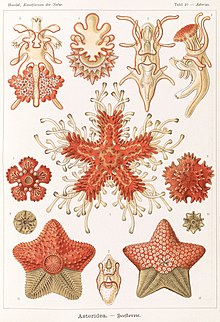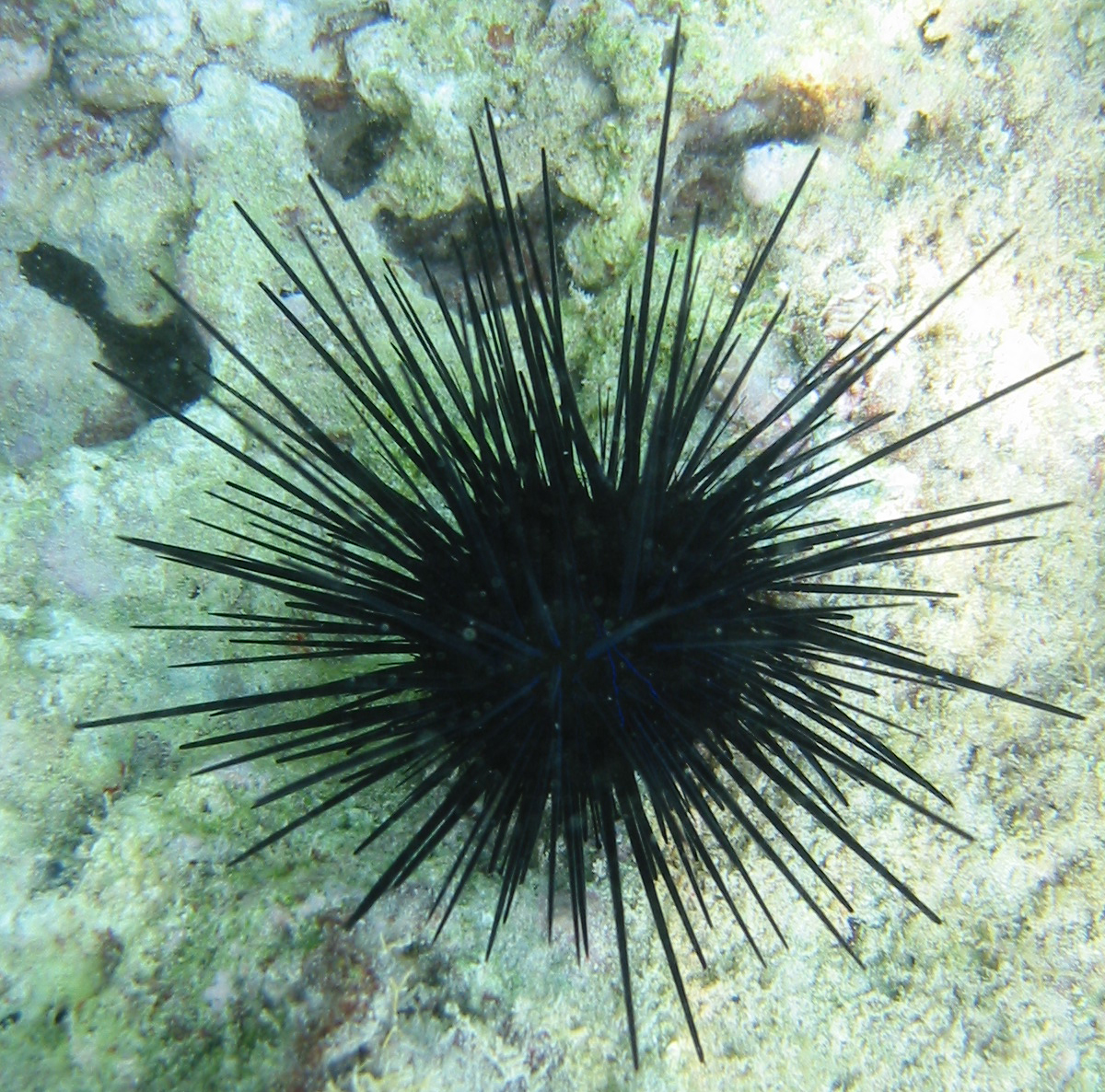Echinoderms (Phylum Echinodermata) are a phylum of marine animals. The adults are recognized easily by their (usually five-point) radial symmetry, and include such well known animals as sea stars, sea urchins, sand dollars, and sea cucumbers. Echinoderms are found at every ocean depth, from the intertidal zone to the abyssal zone. The phylum contains about 70,000 living species, making it the second-largest grouping of deuterostomes (a superphylum), after the chordates (which include the vertebrates, such as humans,sharks and frogs). Echinoderms are also the largest phylum that has no freshwater or terrestrial (land-based) representatives.
The echinoderms are important both biologically and geologically. Biologically, there are few other groupings so abundant in the biotic desert of the deep sea, as well as shallower oceans. The more notably distinct trait, which most echinoderms have, is their remarkable powers of regeneration of tissue, organs, limbs, and of asexual reproduction, and in some cases, complete regeneration from a single limb. Geologically, the value of echinoderms is in their ossified skeletons, which are major contributors to many limestone formations, and can provide valuable clues as to the geological environment. Further, it is held by some scientists that the radiation of echinoderms was responsible for the Mesozoic revolution of marine life.
Knobbly Sea Star
Scientific name: Protoreaster nodosus
 |
| Overview of Echinoderms(Pentaradial symmetry)(R) |
The echinoderms are important both biologically and geologically. Biologically, there are few other groupings so abundant in the biotic desert of the deep sea, as well as shallower oceans. The more notably distinct trait, which most echinoderms have, is their remarkable powers of regeneration of tissue, organs, limbs, and of asexual reproduction, and in some cases, complete regeneration from a single limb. Geologically, the value of echinoderms is in their ossified skeletons, which are major contributors to many limestone formations, and can provide valuable clues as to the geological environment. Further, it is held by some scientists that the radiation of echinoderms was responsible for the Mesozoic revolution of marine life.
Knobbly Sea Star
Scientific name: Protoreaster nodosus
Kingdom:
Animalia
Phylum /
Family: Echinodermata Oreasteridae
Knobbly sea
stars are usually found on reef flats amongst sea grass, or in coral rubble
areas. They can be identified with a single row of knobs alongside the upper
side of each arm. They are relatively huge in size, reaching up to 30cm
diameter when mature. Though their arms appear rather stiff, they can bend
quite extensively to feed on prey. Despite appearing colourful (ranging from
red to green or even white) and dangerous-looking knobs, they are not venomous.
Knobbly sea
stars have tube feet with sucker-shape tips emerging from underside of their
arms. They are extra-oral feeders, but little is known of its biology. Some
suggest they feed on sponges and clams, others claim they eat micro-organisms
and dead creatures.
Knobbly sea
stars are listed among the critically endangered creatures on Singapore.
Extensive harvesting, human industrial activities and land reclamation has
given them little chance of survival. They are now a very uncommon sight in
Singapore.
Sand Sifting Sea Star
 |
| Sand Sifting Sea Star in a tidal pool |
 |
| Sand Sifting Sea Star in a container |
The Sand Sifting Sea Star, at first glance, seems to be drably colored like most bottom dwellers. But closer inspection reveals a striking beauty and serenity to the alternating bands of brown and beige that dress this invertebrate's thick, spine-covered arms. Like other starfish,Astropecten polycanthus efficiently consumes mass amounts of detritus and uneaten foods. This nocturnally active member of the Astropectinidae family can move large amounts of sand as it burrows into the substrate in its search for food.
This sea star is a very popular aquarium pet as it can clean even the largest of tanks of detritus. In the intertidal zone, they bury into the sand to escape predators, and their brownish colour makes them even harder to spot.
ref: http://www.liveaquaria.com/product/prod_display.cfm?c=497+528+572&pcatid=572
Feather Stars
| Feather Star |
There are only a few hundred extant crinoid species, but they were much more abundant and diverse in the past. Some thick limestone beds dating to the mid- to late-Paleozoic are almost entirely made up of disarticulated crinoid fragments.
Crinoids comprise three basic sections; the stem, the calyx, and the arms. The stem is composed of highly porous ossicles which are connected by ligamentary tissue. The calyx contains the crinoid's digestive and reproductive organs, and the mouth is located at the top of the dorsal cup, while the anus is located peripheral to it. The arms display pentamerism or pentaradial symmetry and comprise smaller ossicles than the stem and are equipped with cirri which facilitate feeding by moving the organic media down the arm and into the mouth.
Like other echinoderms, crinoids have pentaradial symmetry. The aboral surface of the body is studded with plates of calcium carbonate, forming an endoskeleton similar to that in starfish and sea urchins. These make the calyx somewhat cup-shaped, and there are few, if any, ossicles in the oral (upper) surface. The upper surface, or tegmen, is divided into five ambulacral areas, including a deep groove from which the tube feet project, and five interambulacral areasbetween them. The anus, unusually for echinoderms, is found on the same surface as the mouth, at the edge of the tegmen.
This feather star was also found on Hantu.
Sea Urchins
Scientific Classification
| Kingdom: | Animalia |
| Phylum: | Echinodermata |
| Subphylum: | Echinozoa |
| Class: | Echinoidea |
 |
| Sea Urchin(R) |
Sea urchins are spiny, hard-shelled creatures that live on rocky seafloor on different depths, from shallow waters to great depths. There are about 700 different species of these invertebrates known. They are very slow movers and move along the seabed. Many sea urchins have venomous spines for protection, much like the stonefish.
Sea urchins have a five-sided radial symmetry. They have hard plates called the test covering their body. Sea urchins have a globular body and long spines protrudes from the body. Spines are used for protection, movement, and trapping food (like algae) to consume. In the centre among the spines are five paired rows of tiny tube feet with suckers that help with locomotion, capturing food, and grasping onto the seafloor. The tiny stinging structures are known as pedicellarines which is used for defense and for obtaining food. They lack a brain like all echinoderms The claw-like mouth is located on the underside; it has 5 tooth-like plates pointing in. The anus and the genitals are on the top of the sea urchin.
They have external fertilisation. Female sea urchins release millions of tiny, jelly coated eggs, and gets fertilised by sperms. it takes several months for sea urchins to form. As they develop, the tiny larvae swim in the sea and are a component of zoo plankton. Then, they take 2 - 5 years to become reproductive matures.
Sea Urchins eat kelp decaying matter, algae and sponges. They are in turn eaten by crabs, sunflower stars, snails and people, who consider them a delicacy.
Sea cucumbers
.JPG) |
| Is that a Sea Cumber? |
Sea cucumbers are echinoderms. Sea cucumbers are sausage shaped, and their skin is covered with warty bumps or soft spines. When threatened, cucumbers can contract their muscles and shoot out water from their body making them shorter, thicker, and harder. Some can even shoot out their insides and then go and grow new insides.
Sea cucumbers have hundreds of tiny suction-cup tube feet that they use to crawl across the sea floor. Three common sea cucumbers are the warty sea cucumber, the California cucumber, and the white star cucumber. Warty sea cucumbers are chestnut brown with black-tipped "warts" all over their bodies. Warty sea cucumbers grow up to ten inches long. California sea cucumbers are brown to reddish-brown and are covered with pointed, cone-shaped projections. The California sea cucumber grows up to sixteen inches long. The white sea cucumber is light orange to white with long, nonretractable spines covering their bodies. White sea cucumbers grow up to four inches long.
ref: http://library.thinkquest.org/J001418/seacuc.html
http://en.wikipedia.org/wiki/Echinoderm
bodrumpeninsulatravelguide.co.uk
http://en.wikipedia.org/wiki/Echinoderm
bodrumpeninsulatravelguide.co.uk
.jpg)


No comments:
Post a Comment